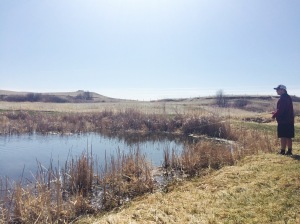As promised, this is my excitement filled post on how I caught my very first fish on a fly rod!!
It was the last day of spring break, and it did not occur without much struggle and heartache and frustration and lots of tears, but I did it!
 I told you about my first cast and how awful it was, well this was a catastrophe compared to that. The stream was very narrow and all of the dead bushes and little sprigs of crispy, hard plants all over the bank did not make my job any easier. Plus it was WINDY as all get out, but I did it!
I told you about my first cast and how awful it was, well this was a catastrophe compared to that. The stream was very narrow and all of the dead bushes and little sprigs of crispy, hard plants all over the bank did not make my job any easier. Plus it was WINDY as all get out, but I did it!
My hook got caught half a billion times, I was sunburnt to a crisp and I got an unbearable migraine afterwards, but I did it!
I was so elated afterwards that I couldn’t wait to get out there and do it again. So, we went as soon as we could which happened to be this last weekend. Saturday was a gorgeous day. I slathered on sunscreen, brought a huge bottle of water, and the confidence that it would only get easier from now on…. I got skunked.
I didn’t even see a fish, let alone catch one. Correction, I saw fish… They were on the end of my boyfriend’s line.
Sunday was a bit colder, but it was more successful. I caught two fish, before my hands felt like they were going to fall off into the pond and become a stocker appetizer.
The first little guy scared me to death for two reasons. 1. I couldn’t believe I caught one so quickly and on the dock all by myself. 2. He had swallowed the hook a-ways and I couldn’t find it to let him go! My boyfriend had to get down into his throat with his vises and pull it out after five minutes of the fish struggling and after five minutes of me crying. But thank heavens, the fish swam away and was perfectly fine!
The second catch was a bigger one, but it was easier to release. And then I was frozen, exhausted, and petrified from seeing a snake, so we called it a weekend.
I am so excited to continue this journey and share it with all of you!



